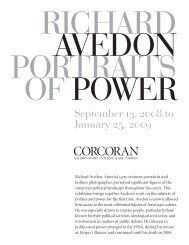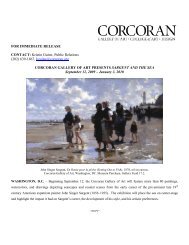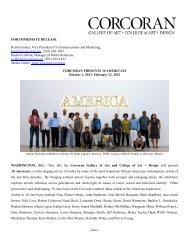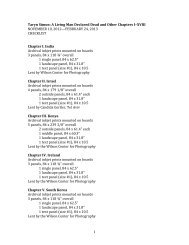Aaron Douglas, Into Bondage, 1936 - Corcoran Gallery of Art
Aaron Douglas, Into Bondage, 1936 - Corcoran Gallery of Art
Aaron Douglas, Into Bondage, 1936 - Corcoran Gallery of Art
Create successful ePaper yourself
Turn your PDF publications into a flip-book with our unique Google optimized e-Paper software.
Jessica Stockholder (born Seattle, WA, 1959–lives and works in New Haven, CT)<br />
, 1994<br />
Plastic sink legs, clothing, trimming, string, yarn, wood, hardware, piece <strong>of</strong> furniture, papier- mâché, plaster, wallpaper paste, glue, acrylic and<br />
oil paint, cable, silicone and latex caulking, and plastic fruit<br />
93 x 50 x 82 in. (236.22 x 127 x 208.28 cm)<br />
Gift <strong>of</strong> the Women’s Committee <strong>of</strong> the <strong>Corcoran</strong> <strong>Gallery</strong> <strong>of</strong> <strong>Art</strong>, 1996<br />
About the <strong>Art</strong>ist<br />
Born in Seattle, Washington, Jessica Stockholder studied painting<br />
at the University <strong>of</strong> British Columbia, Vancouver, and received<br />
a Master <strong>of</strong> Fine <strong>Art</strong>s from Yale University in 1985. She was awarded<br />
an honorary Doctor <strong>of</strong> <strong>Art</strong>s degree from Emily Carr College <strong>of</strong><br />
<strong>Art</strong>, Vancouver, BC, in 2010. Since 1999, she has been on the<br />
faculty at Yale and currently is pr<strong>of</strong>essor and director <strong>of</strong> Graduate<br />
Studies in Sculpture. Stockholder is known for creating multimedia<br />
installations that transcend genres. Her floor and wall pieces have<br />
been described as “paintings in space.” Stockholder’s complicated<br />
installations incorporate the architecture in which they have been<br />
conceived, <strong>of</strong>ten blanketing the floor, scaling the walls and ceiling,<br />
and even spilling out <strong>of</strong> windows and through doors. The works<br />
are no longer made on the surface <strong>of</strong> a canvas (mounted or otherwise),<br />
but in space—the same space in which the spectator exists.<br />
On initial viewing Stockholder’s work may look chaotic, however,<br />
closer observation shows how decisions about the application <strong>of</strong><br />
formal properties have rendered precisely orchestrated inventions.<br />
To create each piece, Stockholder employs a variety <strong>of</strong> everyday<br />
materials such as yarn, toys, laundry baskets, and curtains as well<br />
as construction materials including brick, concrete, plywood, and<br />
sheetrock. Stockholder explores art <strong>of</strong> the past through a humorous<br />
approach to color and composition. Influenced by Henri Matisse,<br />
Stockholder has a strong interest in the pulsating energy that<br />
colors can create in works <strong>of</strong> art. Bringing the vibrant, brightly<br />
colored products <strong>of</strong> consumer culture to her work through found<br />
objects, she later adds painted areas to create dialogues that give<br />
each color maximum optical appeal.<br />
About the <strong>Art</strong><br />
This work from 1994 is a small scale example <strong>of</strong> Stockholder’s<br />
ability to transform unrelated objects into hybridized works <strong>of</strong> art.<br />
It is composed <strong>of</strong> materials that might be found in any typical<br />
home including a small bed, plastic sink legs, clothing, yarn, and<br />
hardware. The bed rests on the floor, tethered to the wall by two<br />
lengths <strong>of</strong> wood that are bolted together and draped with fabric,<br />
some <strong>of</strong> which is painted. The wood is attached to the wall by<br />
a loop <strong>of</strong> wire that hangs on a nail, giving the impression that the<br />
overall composition resembles a three-dimensional painting <strong>of</strong><br />
a brightly colored interior. However, unlike a traditional painting,<br />
it cannot be fully appreciated from one point <strong>of</strong> view and should<br />
be explored from all sides. The work is clearly not created on the<br />
surface <strong>of</strong> a canvas but in space.<br />
Stockholder believes that prefabricated items such as the ones<br />
used here, are raw material for creativity. The painterly surface<br />
<strong>of</strong> the bed is covered in several shades and textures <strong>of</strong> green pigment<br />
topped with a folded rectangle <strong>of</strong> black velvet. Fruit, a traditional<br />
symbol <strong>of</strong> the brevity <strong>of</strong> earthly life in paintings, <strong>of</strong>ten appears in<br />
both real and artificial forms in Stockholder’s work. Here, plastic<br />
produce is cut into sections and nailed onto the red side bar.<br />
“My work <strong>of</strong>ten arrives in the world like an idea arrives<br />
in your mind. You don’t quite know here it came from<br />
or when it got put together, nevertheless it’s possible<br />
to take it apart and see that it has an internal logic.”<br />
Suggested Dialogue<br />
• The work does not have a title, what would you name it?<br />
• Why did the artist attach the art to the wall?<br />
• What could the article <strong>of</strong> black and green clothing on top<br />
<strong>of</strong> the furniture represent?<br />
• There is plastic fruit nailed to a section <strong>of</strong> the work, what do you<br />
think that symbolizes?<br />
• If you were to create a multimedia work <strong>of</strong> art based on things<br />
found at home, what would you use?<br />
Extended Dialogue<br />
• Since Stockholder is using some salvaged material, would she<br />
be considered an environmentally conscious artist?<br />
Vocabulary<br />
Installations: Installation art is an assemblage<br />
or environment specifically created<br />
for a particular interior (very <strong>of</strong>ten a gallery).<br />
Early Installations were viewed as temporary,<br />
many are now intended to be permanent<br />
and are viewed as collectable.<br />
Henri Matisse (1869–1954): Widely regarded<br />
as one <strong>of</strong> the greatest artists <strong>of</strong> the 20th<br />
century, Matisse is known for his use <strong>of</strong><br />
color and his fluid and original draftsmanship.<br />
Known primarily as a painter, he also<br />
created drawings, sculpture, prints, and<br />
cut-paper works.<br />
Hybridized: Something <strong>of</strong> mixed origin<br />
or composition.<br />
.<br />
• Do you think the term “paintings in space” accurately describes<br />
Stockholder’s work?<br />
Support for <strong>Art</strong>s 101 materials is made possible in part by the Women’s Committee <strong>of</strong> the <strong>Corcoran</strong> and the DC Commission on the <strong>Art</strong>s and Humanities.


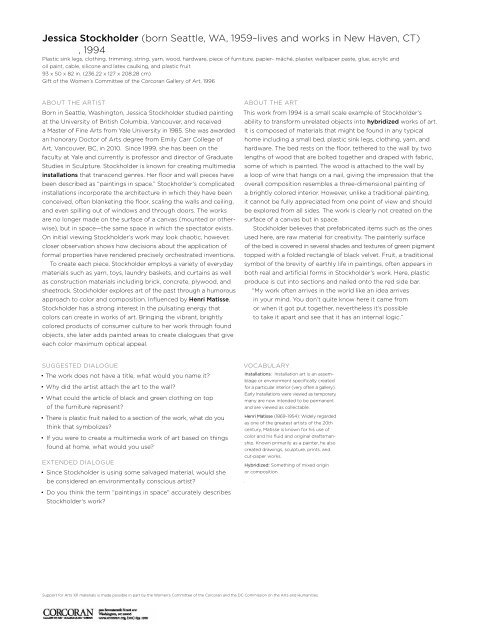
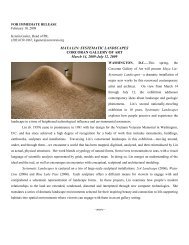
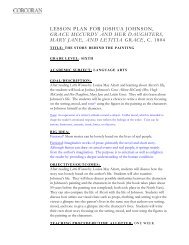
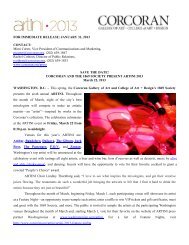


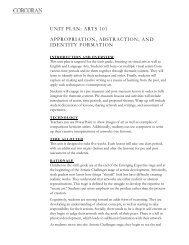
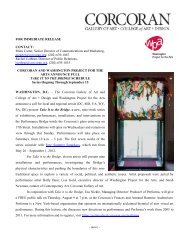

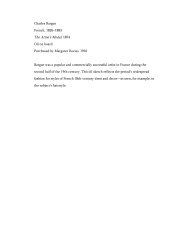
![[PDF] Ellen Harvey: The Alien's Guide to the Ruins of Washington, DC](https://img.yumpu.com/32942537/1/190x190/pdf-ellen-harvey-the-aliens-guide-to-the-ruins-of-washington-dc.jpg?quality=85)
